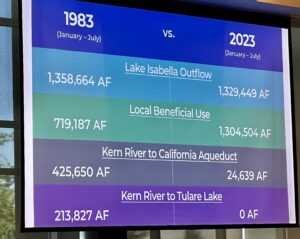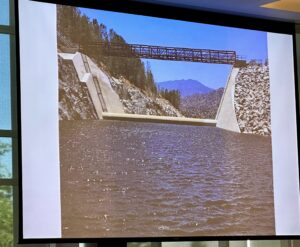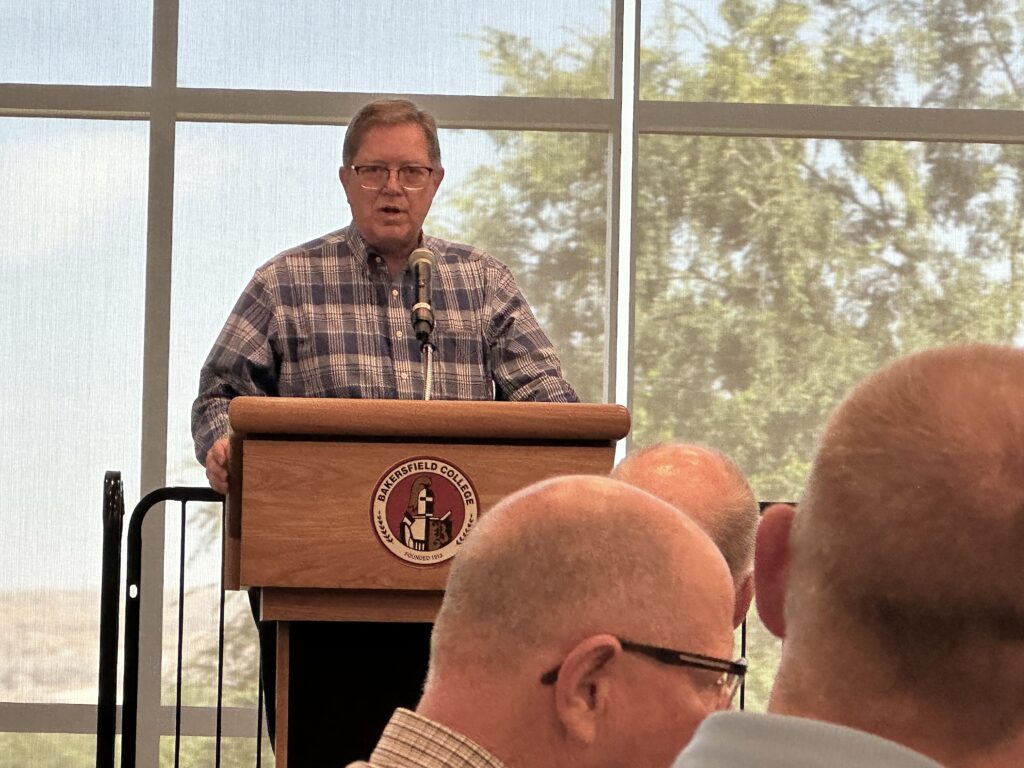Despite a few white knuckle moments, the Kern River’s historic flows were successfully managed through a combination of incredible timing, long term planning and pure luck, according to Kern River Watermaster Mark Mulkay.
During a detailed discussion of Kern River and Isabella Dam operations Tuesday before a packed room, Mulkay led the audience through the run up to this year’s epic runoff. The luncheon discussion was hosted by the Water Association of Kern County at Bakersfield College.
In October, he said, Kern River irrigators were bracing themselves for another horribly dry year on top of three previous horribly dry years.
Even news that the Army Corps of Engineers had finished its years-long safety improvements to the dam wasn’t cause for cheer as irrigators knew they would have to fill the lake to check their work.
“We were petrified the Corps would tell us, ‘No water for you,'” Mulkay said.
Then the storm door opened in November and didn’t close until late April. By then, downstream irrigators faced another challenge: How to safely move massive flows through the Kern River and keep the water in Kern County.
“Typically, the Kern River interests tell the City of Bakersfield how much water they need and the city calls the Corps. But this year, that was flipped on its head and it was the Corps telling us how much water we were going to take.”
Flows peaked around 7,500 cubic feet per second, he said. At that level, the water started to cause damage to Highway 178. Motorists reported a giant gash in the roadway just as the Memorial Day weekend kicked off and the highway was shut down for a time.
“It was actually the barrier that keeps water off the road that was washing out,” Mulkay noted. “It was the same section that was fixed by Caltrans in 2019, but it wasn’t fixed well enough.”
Even at that high level, Mulkay noted, once the Kern hits the valley floor, irrigators start taking water out of the river so by the time it was moving through Bakersfield that 7,500 cfs was reduced to 4,500 cfs.
“The city’s levees are rated for 10,000 cfs, so I was pretty comfortable,” he said.
As the river moves through and past the city, water districts were able to gobble up almost all the rest of the water and sock it away into recharge basins they’ve been building over decades.
For comparison, Mulkay put up slides showing what happened to Kern River Water during the wettest year on record, 1983, compared to this year.
Lake Isabella outflow in each of those years was about 1.3 million acre feet between January and June.
In 1983, though, 425,650 acre feet was routed into the California Aqueduct and lost to Kern County. This year, the first time in 17 years that Kern River flood flows were routed into the aqueduct, that number was 24,639 acre feet.
Also in 1983, 213,827 acre feet of Kern River ran through Bakersfield and turned north emptying out in the old Tulare Lake. This year, that figure was zero.

The difference is that more than 30,000 acres of Kern County land has been made over into recharge ponds by multiple water districts and the City of Bakersfield, Mulkay said.
“We promised the people up in Tulare Lake we would not send any water up there and we didn’t,” he said.
When he looks back, he said, so many factors fell into place just right.
The Corps had just finished its repairs, allowing the lake to fill to its full 568,000-acre-foot capacity.
The drought years had left Lake Isabella with only 50,000 acre feet, so there was plenty of room.
The warm March storm that brought 48,000 cfs of water barrelling through Kernville was followed by a hard freeze covering the snowpack with an icy armor against sunlight.
Finally, the extended, cool weather through spring into early summer slowed run off to a manageable level.
Now, instead of flowing over the spillway as was predicted by the Corps several months ago, it looks like Lake Isabella won’t even hit is maximum fill line. In fact, it has receded from a little more than 550,000 acre feet down to 549,889 acre feet as of Wednesday evening.

Starting August 1, Kern River interests will have to start pulling more water out of the lake to get it down to its required “carry over” level of 170,000 acre feet, Mulkay said.
An attendee asked Mulkay what’s expected for the new water year, which starts October 1.
“I’ve heard rumors that it’s going to be an El Nino year,” he said. “But that’s going to be someone else’s problem.”
As of October 1, Mulkay will retire as the Kern River Watermaster.
Share this:
- Click to share on Facebook (Opens in new window)
- Click to share on Twitter (Opens in new window)
- Click to share on LinkedIn (Opens in new window)
- Click to share on Reddit (Opens in new window)
- Click to share on Tumblr (Opens in new window)
- Click to share on Pinterest (Opens in new window)
- Click to share on Pocket (Opens in new window)
- Click to share on Telegram (Opens in new window)
- Click to share on WhatsApp (Opens in new window)
- Click to print (Opens in new window)








You must be logged in to post a comment.